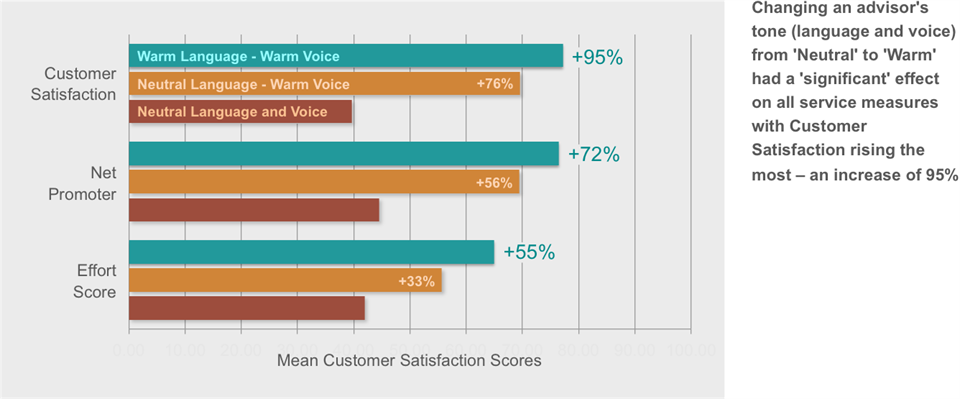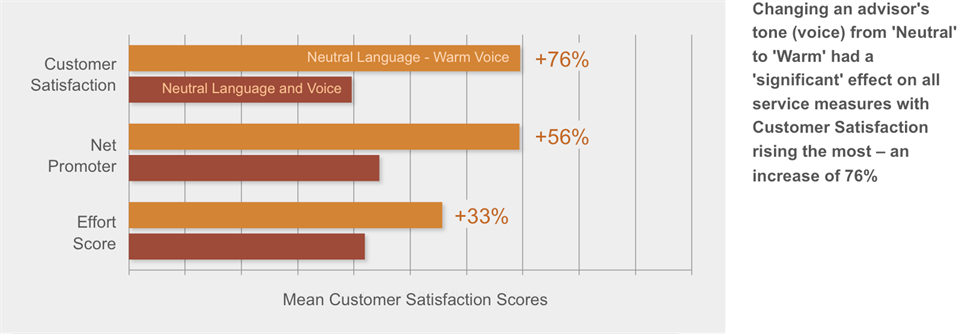Advisor tone – the words that improve service
Our recent research into advisor tone showed how just changing the way words were said (voice) improved customer satisfaction scores by 76%. We also looked at what happened when we changed some of the words (language) too.
The second test
We used the second test to see what would happen to service scores when we changed some of the language the advisor used in the original conversation. The overall approach for this test was the same as the first. If you’re interested you can read about how we ran the first study in Rob’s previous blog.
For the second study we recorded another call, changing about 10% of the advisor’s words to make them less cold / neutral and much ‘warmer’ or empathetic. Only a small proportion of the words were changed so that the structure and outcome of the call stayed the same. Have a look at our our Advisor Language Golden Rules below if you want to find out more about how we changed the language. The advisor’s voice was also warm.
Once again we asked a panel of 200+ consumers to score the call using some common service measures including Customer Satisfaction, Net Promoter Score and Customer Effort.
Changing tone through voice and language makes an even bigger difference to service scores

Figure 1: The effect of voice (the way words were said) and language (what words were said) on service scores (higher scores are better)
An advisor’s tone of voice tells a customer something about their personality, attitudes and emotions. It’s these that actually affect service scores. Tone is just how customers come to understand them.
What ‘sets the tone’ or gives away an advisor’s attitudes and emotions? Clearly it’s the combination of language and voice. But, which has the greatest influence over service scores?
In our study, adding warm language to an already warm voice pushed all the service scores even higher, with Customer Satisfaction climbing the highest – up by 95%. However, given that just a warm voice alone increased Customer Satisfaction by 76%, in this test voice had a greater impact on service scores than language.
What we found is similar to the results of a famous (and often misquoted) study by Prof Albert Mehrabian about what most influenced a listener’s understanding when communicating emotions. Roughly summarised he found the influence was 7% language, 38% voice and 55% facial expression. Between language and voice (facial expression can’t always be clearly understood on a call) voice played the larger part.
Advisor language golden rules
When we changed the language in the call for our study we followed some of the advisor language rules that we use in our spoken tone of voice programmes and when we’re writing scripts for advisors. Here’s a quick summary of those:
1. Be warm and empathetic – it helps if advisors introduce themselves with their first name (they’ll also show that they’re willing to be personally responsible for the outcome of a call too) Using a customer’s name may help to build empathy as well. But, it needs to be handled with care. Also, think about using some of the language that the customer uses.
2. Be positive – say what can be done, not just what can’t be.
3. Be confident – utterances like err, um and erm all show a lack of confidence. As do words like may / could / should. Use positive alternatives like ‘will’ instead, for example: “you will get a confirmation letter in the post”.
4. Be clear – try to be specific if you can. For example, instead of saying: “we’re here most days”, say: “we’re here Monday to Friday”. Also, try not to use jargon that customers may not understand (it’s also possible they won’t query it as they’ll feel stupid if they do). Once again, consider using some of the terms that customers use.
5. Be active – use active rather than passive sentences. An easy way to do this is to put yourself at the front of a sentence. So, instead of saying; “the pack will be sent by us on the 14th”, say; “We’ll send the pack on the 14th”.
6. Be adaptable – not all customers are the same and it’s helpful to adapt language to suit them. For example, some customers may simply want a call completed as quickly as possible and appreciate concise language. Whereas, others may be happier to chat and don’t mind longer descriptions and more discussion.
If you want to know more about how we can help you to develop your advisors’ tone skills please get in touch.






